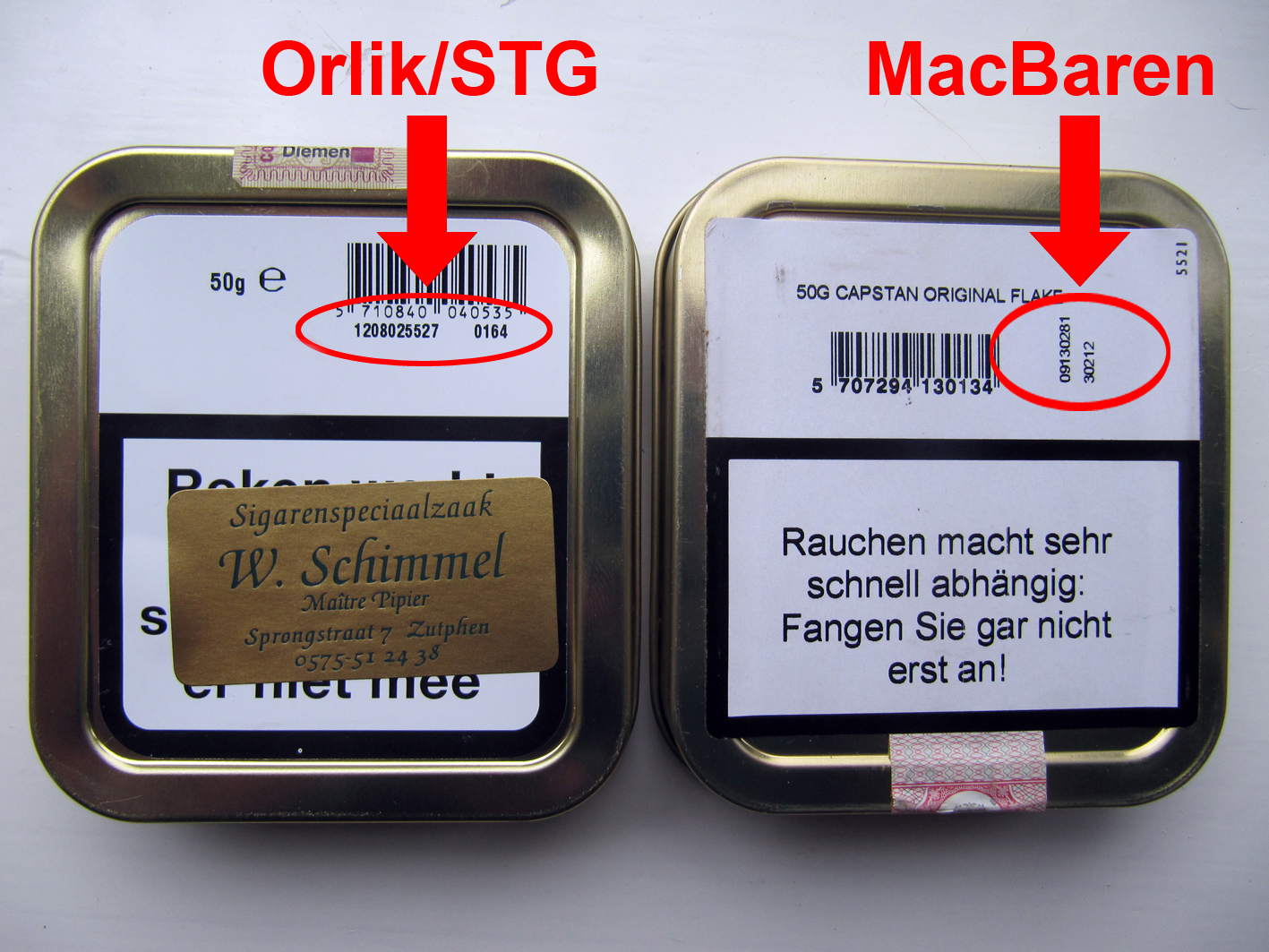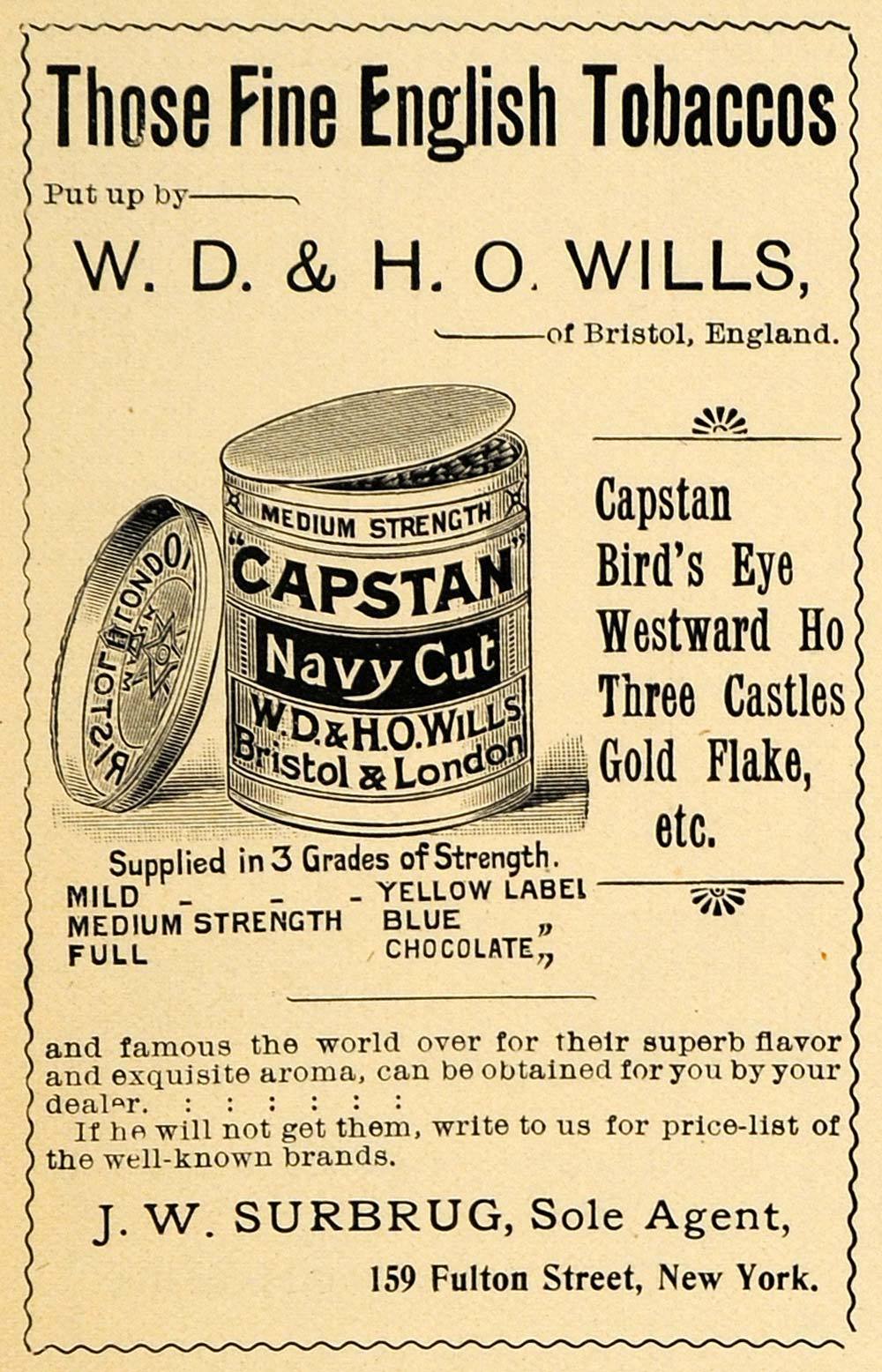These days there is a lot of news surrounding Capstan. This because after an absence of 18 years the legendary brand returns to the USA. Not only as the well-known flake, but also as the lesser-known ready rubbed. Also the manufacturer is no longer Orlik / STG, but another Danish company, MacBaren. Of course under license of Imperial Tobacco. Luckily we in Europe were able to enjoy Capstan all this time. It actually is one of the few tobaccos that is available in The Netherlands that I like very, very much.
Capstan already exists for a looong time. The brand was introduced by W. D. & H. O. Wills around 1893. The company was founded as Wills, Watkins & Co. by Henry Overton Wills I and his partner Watkins. He opened a shop in 1786 Castle Street, Bristol in 1786. After the retirement of his partner in 1789 the name became “Wills & Co.”. From 1791 to 1793 the company was known as Lilly, Wills & Co when it merged with the firm of Peter Lilly. Then, from 1793 to Lillly’s retirement in 1803, as Lilly and Wills.In 1826 Wills’ two sons, William Day Wills and Henry Overton Wills took over the company and finally in 1830 the company took the well known name of W. D. & H. O. Wills.
The company was good for its workers and pioneered canteens, free medical care, sports facilities and paid holidays. Their first brand was “Bristol”, made at the London factory from 1871 to 1974. “Three Castles” and “Gold Flake” followed in 1878, “Woodbine” in 1888, Capstan around 1893 and Three Nuns from 1957 to the late 1980’s. The company not only had factories and offices in Bristol, but also in Swindon, Dublin, Newcastle and Glasgow. The largest cigarette factory in Europe was opened at Hartcliffe Bristol in 1974 but closed in 1990. The beautiful Art Deco Newcastle factory closed in 1986. In 1901 Sir William Henry Wills formed the Imperial Tobacco company from a merger of W.D. & H.O. Wills with John Player & Sons of Nottingham and 11 other independent family businesses, which were being threatened by competition from the United States by the American Tobacco Company. Imperial remains one of the world’s largest tobacco companies. The last member of the Wills family to serve the company was Christopher, the great great grandson of H.O. Wills I. He retired as sales research manager in 1969. Some time after the closure of the Bristol plant the making of Capstan was finally licensed by Imperial Tobacco to Orlik and now MacBaren. For more (old) pictures of the W.D. & H.O. Wills factories click on this link.
My love for Capstan began when I made a bid on an old Medium Navy Cut tin on the British e-bay. And did not win it.. Fortunately something went wrong with the winner and the seller approached me if I wanted the tin. Of course, but not for the money the winner offered. I’m still Dutch after all. That was possible and after some price negotiations she sent me the tin. It was my first vintage tobacco so I eagerly pried with my Czech pipe-tool under the lid and was rewarded with a *Ssssssss*. The flakes inside smelled absolutely hea-ven-ly. Since then I never came across a vintage tobacco that smelled so nice. A deep, sweet hay / grass/ raisins / figs aroma that reminded me of the hay-barn of my uncle and aunt. Even to this day, when I stick my nose in a Capstan tin I have to think of that. *Sighs* Good ol’ times.. Speaking about those, Capstan used to be the favourite tobacco of well known writer J.R.R. Tolkien and also later of his son Christopher until he quit smoking..
When I put a flake in my Winslow Harlekin and lit it my taste buds had a shuddering orgasm. Before that I smoked some aromatics and wasn’t converted to the dark latakia leaf yet. The taste was full and naturally sweet with the hints of hay and raisins / figs that I smelled before. In other words, the Virginias had aged very well. Yes, that old Capstan really was an eye opener. So I mailed the e-bay lady if she had any more tins left that she was willing to sell and asked how she got does. She answered that she had acquired them from the left over inventory of a closed tobacco-shop and that she had a couple more tins left. I bought those and I still have them. Only on very special occasions I pop one open. After I finished the old Capstan I went looking for the new version. I was in luck, the local tobacco store had one left. When I got home I opened it and was a bit disappointed. Yes the sweet hay/grass/ raisins / figs aroma was there but it lacked the depth of the Old Capstan. But that is not so strange since it was a new tin..
When I did some research about the Capstan topping (I knew it wasn’t all-natural) I stumbled upon the used flavour in the earlier years. It had the code-name STANUNED. After some more research I discovered that the Tonka bean (tonquin, coumarin) was used as an ingredient. Unfortunately the use of tonka bean in pipe-tobacco is now prohibited in most countries.. So I wonder how the current topping is made. A chemical rip-off? Imperial Tobacco has the original recipe so who knows what they have done to it over the years..

Different Capstan tins fltr: W.D. & H.O. Wills tin, older Orlik/STG tin, later Orlik/STG tin, MacBaren tin
Ok, now it is time to do some comparisons between the Orlik / STG version and the new MacBaren version. As you can see in the picture on the left both the latest Orlik / STG tin and the new MacBaren one are identical. The folks in the USA are fine, every new tin is the MacBaren version plus it has the manufacturing month and year clearly stated on the back. But here in Europe we have some “old” Orlik / STG stock left that looks exactly the same as the new one! The same yes, only the codes on the back of the tin are different.
 Let me explain. On the picture on the right you see the backside of the two similar Capstan tins. Left the Orlik / STG version, right the new MacBaren. The Orlik / STG tin has 10 digits and then 4. The MacBaren one has 8 and then 5. That is the difference. As you zoom in on the MacBaren tin you see: 09130281 30212. This is how the code can be deciphered:
Let me explain. On the picture on the right you see the backside of the two similar Capstan tins. Left the Orlik / STG version, right the new MacBaren. The Orlik / STG tin has 10 digits and then 4. The MacBaren one has 8 and then 5. That is the difference. As you zoom in on the MacBaren tin you see: 09130281 30212. This is how the code can be deciphered:
– 09 = Packing machine used
– 13 = Year of packing
– 028 = Calendar day of production. That means day 028 in 2013. January 28th.
– 1 = Shift (1 indicates it is packed on the day shift)
– The 5 digit number is the internal batch number.
The Orlik / STG tin code is a bit harder to crack: 1208025527 0164.
– 12 = Year of packing
– 08 = Calender day of production. That means the 8th day of the month.
– 02 = Month of packing.
What the rest of the digits mean, no idea.. The 4 digit number is an internal batch number I guess. But this tin comes from February 8th 2012.
 When you open both tins the flakes inside look the same (I already smoked from the MacBaren version at the time of the picture). Ok, maybe the Orlik / STG verison is a tiny bit darker but that is because it is almost a year older. The tin odour is also almost the same although I find that the MacBaren version smells just a bit sharper. Also maybe because of the youthfulness of the flake. I must say that that sharp edge goes away after a week after opening. For the last one and a half week I have been smoking both versions extensively in different pipes. And… I can detect no real difference. They both are a damn fine smoke. The Orlik / STG version tastes just a bit rounder, fuller but once again, that could very well be the age difference. Also Orlik / STG have brought 2 flakes on the market: Orlik English Original and Orlik English Gold. I have not smoked these but it is said that they are similar to the Blue and Yellow Capstan.
When you open both tins the flakes inside look the same (I already smoked from the MacBaren version at the time of the picture). Ok, maybe the Orlik / STG verison is a tiny bit darker but that is because it is almost a year older. The tin odour is also almost the same although I find that the MacBaren version smells just a bit sharper. Also maybe because of the youthfulness of the flake. I must say that that sharp edge goes away after a week after opening. For the last one and a half week I have been smoking both versions extensively in different pipes. And… I can detect no real difference. They both are a damn fine smoke. The Orlik / STG version tastes just a bit rounder, fuller but once again, that could very well be the age difference. Also Orlik / STG have brought 2 flakes on the market: Orlik English Original and Orlik English Gold. I have not smoked these but it is said that they are similar to the Blue and Yellow Capstan.
 Truthfully I never expected that MacBaren could pull off a tobacco that I actually like very much. I am not a big MacBaren fan to be honest.. But they have done a damn fine job with the new Capstan, I got to give them credit for that. And for the people who say, it tasted better in the past! Yes, the old W.D. & H.O. Wills tins taste superior. But keep in mind the formidable ageing of the Virginias! Anyway, I am just glad that I can buy a new tin of an old brand without worrying.
Truthfully I never expected that MacBaren could pull off a tobacco that I actually like very much. I am not a big MacBaren fan to be honest.. But they have done a damn fine job with the new Capstan, I got to give them credit for that. And for the people who say, it tasted better in the past! Yes, the old W.D. & H.O. Wills tins taste superior. But keep in mind the formidable ageing of the Virginias! Anyway, I am just glad that I can buy a new tin of an old brand without worrying.






